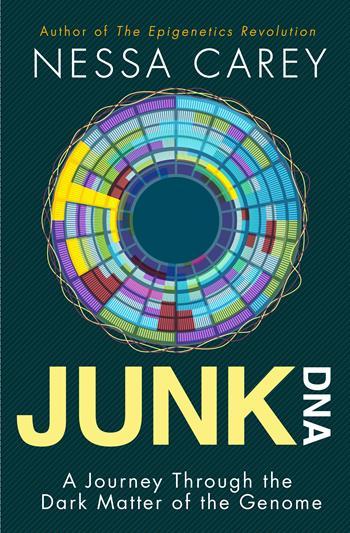The Drugs Do Work (Sometimes) — Nessa Carey on Junk DNA and Medicine
“One day science will probably be able to interpret all the possible epigenetic modifications that are found in the genome and predict precisely what their consequences will be for gene expression. But unravelling the reasons behind the triumph of hope over experience in the investment community? Be realistic.”—Nessa Carey
In the final post for our week-long feature on Junk DNA: A Journey Through the Dark Matter of the Genome, by Nessa Carey, we’ve provided an excerpt from the penultimate chapter, “The Drugs Do Work (Sometimes). In the chapter Carey explains how drug companies are building on new discoveries relating to junk DNA to develop new drugs. However, as Carey points out, the time and money they’re willing to devote to research and development is not consistent and often results in slowing down progress:
Billions of dollars are spent every year by companies trying to create new drugs to treat human diseases. They hope to find ways to tackle unmet medical needs, a situation that is becoming ever more urgent with the increasing age profile of the global population. The breakthroughs in the understanding of the impact of junk DNA on gene expression and disease progression are triggering a slew of new companies seeking to exploit this field. Specifically, most of the new efforts are in using non-protein-coding RNAs as drugs in themselves. The basic premise is that junk RNA – long non-coding, smallRNAs or another form called antisense – will be given to patients, to influence gene expression and control or cure disease.
This is very different from the way we treat diseases at the moment. Historically, most drugs have been of a type known as small molecules. These are chemically created and are relatively simple in shape. More recently, we have learnt how to use proteins as drugs. Probably the most famous is insulin, the hormone that diabetics use to regulate their blood sugar levels. Antibodies are another very successful type of protein drug. These are engineered versions of the molecules we all produce to fight infections. Drug companies have found ways of adapting these so that they will bind to over-expressed proteins and neutralise their activities. The bestselling antibody is one that treats rheumatoid arthritis very effectively, but there are others that treat conditions as diverse as breast cancer and blindness.
Small molecules and antibodies have advantages and drawbacks. Small molecules are usually relatively cheap to synthesise and easy to administer, frequently just needing to be swallowed. Their drawback is that they don’t last very long in the body, which is why we need to take them on a regular basis. Antibodies can last for weeks or even months in the body, but they have to be injected by a medical professional, and they are very expensive to manufacture.
There are some other drawbacks too. Antibodies are only effective against molecules that are in body fluids such as blood, or are on the surface of cells. These drugs can’t get inside cells to do their work. Depending on their structure, small molecules can get inside cells if necessary. But they may be limited in the kinds of proteins that they can control.
Small molecules act like a key in a lock. If you are inside your house, the easiest way to stop someone coming in is to lock your door and leave the key in it. If you wanted to stop anyone else from ever entering, you could even lock the door using a slightly defective key, which jams the lock for ever.
This works because the key fits into the lock really snugly. But what you can’t do is use a key to block one of those old-fashioned external sliding bolts. There is nowhere for the key to fit in this, it will just keep slipping around on the surface. This is also true of our cells. There are lots of proteins inside our cells that we would like to control but we can’t create small molecules against them, because of the protein structure. They don’t have nice neat clefts or pockets that we can fit drugs into. Instead, they have large flat surfaces, and there is nowhere for a small molecule to lodge.
We could try to make bigger molecules that can cover the whole flat surface. The problem with this is that once we get above a certain size with our drugs they don’t circulate well around the body, and they can’t get into the cells to do their job.
There’s also another problem. It’s hard enough to create drugs that will successfully get inside cells, bind to a specific protein, and stop that protein from working. But it’s incredibly difficult to create drugs that will get inside cells, bind to a specific protein and then make that protein work harder, or faster, or better. And it’s practically impossible to make traditional drugs that will drive up the expression of one specific protein, or switch on one and only one gene.
Could junk DNA save us?
This is why there is so much interest in finding new approaches to drug therapies, and why the increasing knowledge of junk DNA is so important. By using long non-coding RNAs or smallRNAs, it is theoretically possible to target pathways that can’t be tackled using traditional small molecule or antibody drugs. It won’t matter that the targets are inside cells and have large flat surfaces. It won’t matter that we need to increase expression or activity of a protein
or gene. We can use this new approach to tackle any type of target.
Theoretically.
That’s the word to focus on. Theoretically. Ideas are common, success is rare. So it’s worth taking a good look at where the reality is before we all cash in our pensions to invest in the latest biotech company working in this space. There is a lot of activity going on, so it’s worth concentrating our analysis on a few leading examples.
There is a protein produced in the liver that is responsible for transporting some other molecules around the body. Globally, there are about 50,000 people who have inherited a mutation in the gene that produces this protein. There are lots of different mutations, but they all seem to have a similar effect. They all change the activity of the protein so that it starts to transport the wrong molecules.
When this happens, deposits, which include a mixture of normal and mutated protein, begin to build up in tissues. Patients may have a range of symptoms, depending on the tissues in which the deposits build up. In about 80 per cent of known cases, the heart is the main organ that is affected, and this leads to potentially lethal cardiac defects. In many of the other 20 per cent of cases, the deposits build up in the nerves and spinal cord. This can lead to debilitating problems with a range of organs, including abnormal and painful sensory responses to mild stimuli.
A company called Alnylam has created a smallRNA, attached to sugar molecules, which can be injected into patients. The small-RNA binds to the untranslated region at the end of the messenger RNA that codes for the protein that is mutated in this disease. This targets the messenger RNA for destruction.
In 2013 the company released data from a phase II clinical study of their drug. They found that when they injected the drug into patients, there was a rapid and sustained drop in the circulating levels of the mutated and normal versions of the protein. This is encouraging, but not yet a cure. The assumption is that a drop in circulating levels will lead to a slowdown in the build-up of tissue deposits. This in turn should lead to at least a slowdown in the progress of the disease. But we won’t know if that is the case until a bigger trial is carried out, in which the actual symptoms and disease progression are monitored. Only if the drug impacts on these will it be considered a success.
A different company, called Mirna Therapeutics, has created a smallRNA which mimics one known to be important in cancer. The endogenous smallRNA is a tumour suppressor, and its overall effect is to hold back cell proliferation. It does this by negatively regulating the expression of at least twenty other genes that try to push the cells into division. Expression of this smallRNA is often lost or decreased in cancer patients, removing the brakes on cell division. The hope is that by reintroducing it into cells, the normal pattern of gene regulation will be restored, and the cells will stop proliferating so quickly.
The company has tested their mimic in patients with liver cancer. So far the trials have just been designed to see what doses of the drug the patients are able to tolerate. It will be some time before we will know if this approach is going to result in clinical benefit.
There is a clever, although not immediately obvious, angle to the products being developed by both Alnylam and Mirna. One of the biggest problems that companies have faced in the past when trying to develop drugs around nucleic acids has been the body’s own detoxification abilities. This is also often a problem for traditional drug discovery as well. Essentially, when a new chemical of any type enters the body, there is a very high likelihood that it will go to the liver. One of the main jobs of this vastly energetic organ is to detoxify anything it doesn’t like the look of. For all of our evolutionary history, this has served us well, protecting us from toxins in food. But the problem is that the liver has no means of distinguishing between toxins we want to avoid, and drugs we are trying to use. It will just drag them in, and try to destroy them.
To use an old rubric, Alnylam and Mirna are making a virtue from a necessity. Alnylam is targeting expression of a protein that is produced in the liver. Mirna is trying to develop treatments for liver cancer. Their molecules will be taken up by exactly the organ they want them to reach. The companies have adapted the structure or packaging of their molecules to try to ensure that once they are in the liver, they will survive long enough in the cells to do their job. SmallRNA approaches have been put forward for a number of other conditions, and the preliminary cellular and animal experiments often look good. But for a condition such as amyotrophic lateral sclerosis, where the nucleic acids will h







